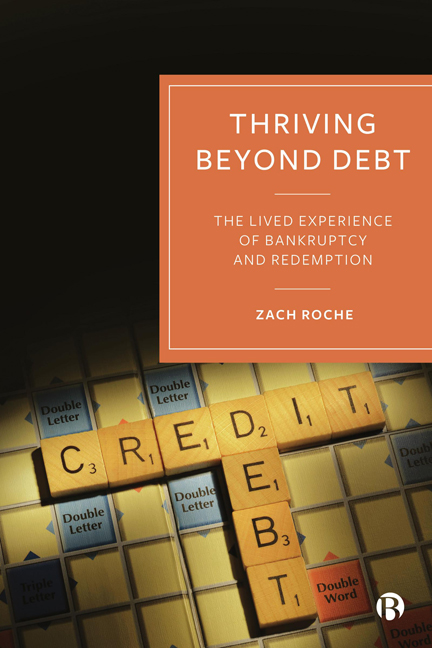Book contents
- Frontmatter
- Dedication
- Contents
- List of Abbreviations and Acronyms
- About the Author
- Acknowledgements
- 1 Introduction
- 2 A Deluge of Debt
- 3 The Uncertainties of Debt
- 4 Opening the Sweatbox: Purgatory and Debt Advice
- 5 Applying for Insolvency
- 6 A Clean Slate
- 7 Coping and Surviving
- 8 Conclusion: Thriving beyond Debt
- Notes
- Bibliography
- Index
4 - Opening the Sweatbox: Purgatory and Debt Advice
Published online by Cambridge University Press: 19 December 2024
- Frontmatter
- Dedication
- Contents
- List of Abbreviations and Acronyms
- About the Author
- Acknowledgements
- 1 Introduction
- 2 A Deluge of Debt
- 3 The Uncertainties of Debt
- 4 Opening the Sweatbox: Purgatory and Debt Advice
- 5 Applying for Insolvency
- 6 A Clean Slate
- 7 Coping and Surviving
- 8 Conclusion: Thriving beyond Debt
- Notes
- Bibliography
- Index
Summary
Most of those who fall into debt distress ardently believe that the problem is merely a temporary setback and that time will provide the means to recover. While some get back on track, the sheer volume of debt in the modern era (see Chapter 2) means that many do not. These people may teeter between ruin and recover for years or even decades at a time, a phenomenon known as the sweatbox of bankruptcy (Foohey et al 2018). In this chapter I will unpack what it is like to live in the sweatbox through a metaphor inspired by economic theology: purgatory. Like purgatory, the sweatbox is defined by difficulties in comprehending time, where a day can feel like a year and vice versa. Further, the purgatorial sweatbox has a crucial transformative role for the debtor as it gets them psychologically and morally ready for bankruptcy. Research shows that many remain in the sweatbox due to an inability to afford the legal fees, but also due to shame, stigma, and anxiety (Porter and Thorne 2006). These latter elements are what I wish to focus on, as it is ‘cheaper’ to go bankrupt or insolvent in Ireland relative to the UK or the US, and so this plays less of a factor in decision making. Indeed, many Irish debtors remain in the purgatorial sweatbox even when they know insolvency is a calculatedly superior option, purely because they believe they deserve to suffer.
However, this suffering is not without purpose. As we will see in Chapter 5, the debtor will be able to present the sacrifices they have made to their insolvency practitioner as evidence of hardship, and thereby increase their chances of gaining the support of this crucial gatekeeper. My characterization of this time as purgatorial is deliberate, because while this experience is harsh, it is not the same as damnation, as we will see in Chapter 7. The difference lies in the absence of hope: at this point in the story, debtors are feeling uneasy about their prospects of recovery, but they remain in negotiations with their creditors and develop a growing awareness of what insolvency could do for them.
- Type
- Chapter
- Information
- Thriving Beyond DebtThe Lived Experience of Bankruptcy and Redemption, pp. 49 - 70Publisher: Bristol University PressPrint publication year: 2024

